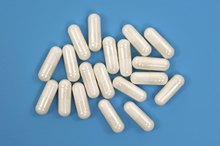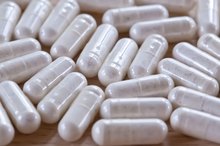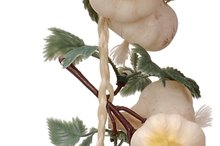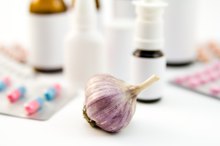What does fact checked mean?
At Healthfully, we strive to deliver objective content that is accurate and up-to-date. Our team periodically reviews articles in order to ensure content quality. The sources cited below consist of evidence from peer-reviewed journals, prominent medical organizations, academic associations, and government data.
- Obstetrics and Gynecology: Prevalence of Bacterial Vaginosis.
- Obstetrics and Gynecology: Prevalence of Bacterial Vaginosis.
- Obstetrical and Gynecological Survey: Common Complementary and Alternative Therapies for Yeast Vaginitis and Bacterial Vaginosis: A Systematic Review.
- Obstetrical and Gynecological Survey: Common Complementary and Alternative Therapies for Yeast Vaginitis and Bacterial Vaginosis: A Systematic Review.
- Journal of Applied Microbiology: Antifungal Activity of the Components of Melaleuca alternifolia (Tea Tree) Oil.
- Journal of Applied Microbiology: Antifungal Activity of the Components of Melaleuca alternifolia (Tea Tree) Oil.
- Lancet: Tea Tree Oil and Anaerobic (Bacterial) Vaginosis.
- Lancet: Tea Tree Oil and Anaerobic (Bacterial) Vaginosis.
- Obstetrics and Gynecology: Intravaginal Practices and Risk of Bacterial Vaginosis and Candidiasis Infection Among a Cohort of Women in the United States.
- Obstetrics and Gynecology: Intravaginal Practices and Risk of Bacterial Vaginosis and Candidiasis Infection Among a Cohort of Women in the United States.
- Journal of Applied Microbiology: The Etiology of Bacterial Vaginosis
- Journal of Applied Microbiology: The Etiology of Bacterial Vaginosis
The information contained on this site is for informational purposes only, and should not be used as a substitute for the advice of a professional health care provider. Please check with the appropriate physician regarding health questions and concerns. Although we strive to deliver accurate and up-to-date information, no guarantee to that effect is made.
4 Ways to Cure Bacterial Vaginosis Naturally
The healthy vagina contains an abundance of "good bacteria," or normal flora. The normal flora help prevent overgrowth by disease-causing organisms, including bacteria. Bacterial vaginosis, or BV, is a common condition in which the vaginal bacteria are out of balance. In BV, the normal flora are reduced and other bacteria increase dramatically leading to symptoms of vaginal discharge, irritation, or odor. BV is a common reason to visit a gynecologist, and is often treated with antibiotics. However, many women prefer alternative or natural remedies such as probiotics, botanical treatments and preventive measures.
If you are experiencing serious medical symptoms, seek emergency treatment immediately.
Restoring the Bacterial Balance
The idea behind probiotic therapy is to use live microorganisms to prevent disease or restore health. Lactobacillus is the most important kind of bacteria in the normal flora. Lactobacillus may be given by mouth -- in capsules or as an ingredient in yogurt -- or directly applied to the vagina. According to a article published in the May 2003 issue of "Obstetrical and Gynecological Survey," several small, randomized trials have shown that Lactobacillus therapy reduces episodes of BV.
- The idea behind probiotic therapy is to use live microorganisms to prevent disease or restore health.
- According to a article published in the May 2003 issue of "Obstetrical and Gynecological Survey," several small, randomized trials have shown that Lactobacillus therapy reduces episodes of BV.
Tea Tree Oil?
Over-the-Counter Treatment for Bacterial Vaginosis
Learn More
Tea tree oil is derived from the leaves of the tea tree 3. It contains a class of chemicals called terpenes which act against bacteria and yeast in laboratory studies. One potential benefit of this approach for BV is that Lactobacillus is relatively resistant to terpenes. Tea tree oil is effective against many types of bacteria in vitro and is often recommended for BV. Tea tree oil is given in capsules that are inserted directly into the vagina.
- Tea tree oil is derived from the leaves of the tea tree 3.
- Tea tree oil is effective against many types of bacteria in vitro and is often recommended for BV.
Garlic?
Garlic is known as a natural antibiotic. Its active ingredient, allicin, is effective against many types of bacteria in laboratory studies. The antibacterial effect is highest when the garlic is crushed, and lower if the garlic is dried or powdered or the oil extracted.
The Physician's Desk Reference for Herbal Medicine does not include treatment of BV among the recognized uses of garlic 7.
- Garlic is known as a natural antibiotic.
- The antibacterial effect is highest when the garlic is crushed, and lower if the garlic is dried or powdered or the oil extracted.
Prevention
Should I Take a Probiotic Every Day?
Learn More
Douching, in particular, is a known risk factor for BV. The risk of BV may be reduced by avoiding practices that disrupt the normal flora of the vagina.
Warnings and Precautions
Natural treatments may have side effects. Treatment with Lactobacillus usually does not have side effects, although some people may experience mild gas or bloating. Probiotic studies can be difficult to interpret. Some strains of Lactobacillus may be more helpful for BV than others. Other than Lactobacillus-containing probiotics, no natural BV treatments have been studied in clinical trials to determine effectiveness, proper dosing or safety. Allergic reactions may occur after using tea tree oil or garlic, and interactions with other medications are possible. Talk to your doctor about which natural remedies may be right for you.
- Natural treatments may have side effects.
- Some strains of Lactobacillus may be more helpful for BV than others.
Related Articles
References
- Obstetrics and Gynecology: Prevalence of Bacterial Vaginosis.
- Obstetrical and Gynecological Survey: Common Complementary and Alternative Therapies for Yeast Vaginitis and Bacterial Vaginosis: A Systematic Review.
- Journal of Applied Microbiology: Antifungal Activity of the Components of Melaleuca alternifolia (Tea Tree) Oil.
- Lancet: Tea Tree Oil and Anaerobic (Bacterial) Vaginosis.
- Obstetrics and Gynecology: Intravaginal Practices and Risk of Bacterial Vaginosis and Candidiasis Infection Among a Cohort of Women in the United States.
- Journal of Applied Microbiology: The Etiology of Bacterial Vaginosis
- Physician's Desk Reference for Herbal Medicines; J Gruenwald, PhD, et al.
- Miller EA, Beasley DE, Dunn RR, Archie EA. Lactobacilli dominance and vaginal pH: why is the human vaginal microbiome unique?. Front Microbiol. 2016;7:1936. doi:10.3389/fmicb.2016.01936
- Lobo, RA, Gershenson, DM, Lentz, GM, Valea, FA. Comprehensive Gynecology. New York, NY: Elsevier Health Sciences; 2016.
- Heczko PB, Tomusiak A, Adamski P, et al. Supplementation of standard antibiotic therapy with oral probiotics for bacterial vaginosis and aerobic vaginitis: a randomised, double-blind, placebo-controlled trial. BMC Womens Health. 2015;15:115. doi:10.1186/s12905-015-0246-6
- De Alberti D, Russo R, Terruzzi F, Nobile V, Ouwehand AC. Lactobacilli vaginal colonisation after oral consumption of Respecta(®) complex: a randomised controlled pilot study. Arch Gynecol Obstet. 2015 Oct;292(4):861-7. doi:10.1007/s00404-015-3711-4.
- Murina F, Graziottin A, Vicariotto F, De Seta F. Can Lactobacillus fermentum LF10 and Lactobacillus acidophilus LA02 in a slow-release vaginal product be useful for prevention of recurrent vulvovaginal candidiasis?: A clinical study. J Clin Gastroenterol. 2014 Nov-Dec;48 Suppl 1:S102-5. doi:10.1097/MCG.0000000000000225.
- Vodstrcil LA, Walker SM, Hocking JS, Law M, Forcey DS, Fehler G, Bilardi JE, Chen MY, Fethers KA, Fairley CK, Bradshaw CS. Incident bacterial vaginosis (BV) in women who have sex with women is associated with behaviors that suggest sexual transmission of BV. Clin Infect Dis. 2015 Apr 1;60(7):1042-53. doi:10.1093/cid/ciu1130.
- Boskey ER, Cone RA, Whaley KJ, Moench TR. Origins of vaginal acidity: high D/L lactate ratio is consistent with bacteria being the primary source. Hum Reprod. 2001 Sep;16(9):1809-13.
- Boskey ER, Telsch KM, Whaley KJ, Moench TR, Cone RA. Acid production by vaginal flora in vitro is consistent with the rate and extent of vaginal acidification. Infect Immun. 1999 Oct;67(10):5170-5.
- Recine N, Palma E, Domenici L, Giorgini M, Imperiale L, Sassu C, Musella A, Marchetti C, Muzii L, Benedetti Panici P. Restoring vaginal microbiota: biological control of bacterial vaginosis. A prospective case-control study using Lactobacillus rhamnosus BMX 54 as adjuvant treatment against bacterial vaginosis. Arch Gynecol Obstet. 2015 Jul 5.
- Taha TE, Hoover DR, Dallabetta GA, Kumwenda NI, Mtimavalye LA, Yang LP, Liomba GN, Broadhead RL, Chiphangwi JD, Miotti PG. Bacterial vaginosis and disturbances of vaginal flora: association with increased acquisition of HIV. AIDS. 1998 Sep 10;12(13):1699-706.
Writer Bio
This article was written by the CareerTrend team, copy edited and fact checked through a multi-point auditing system, in efforts to ensure our readers only receive the best information. To submit your questions or ideas, or to simply learn more about CareerTrend, contact us [here](http://careertrend.com/about-us).








